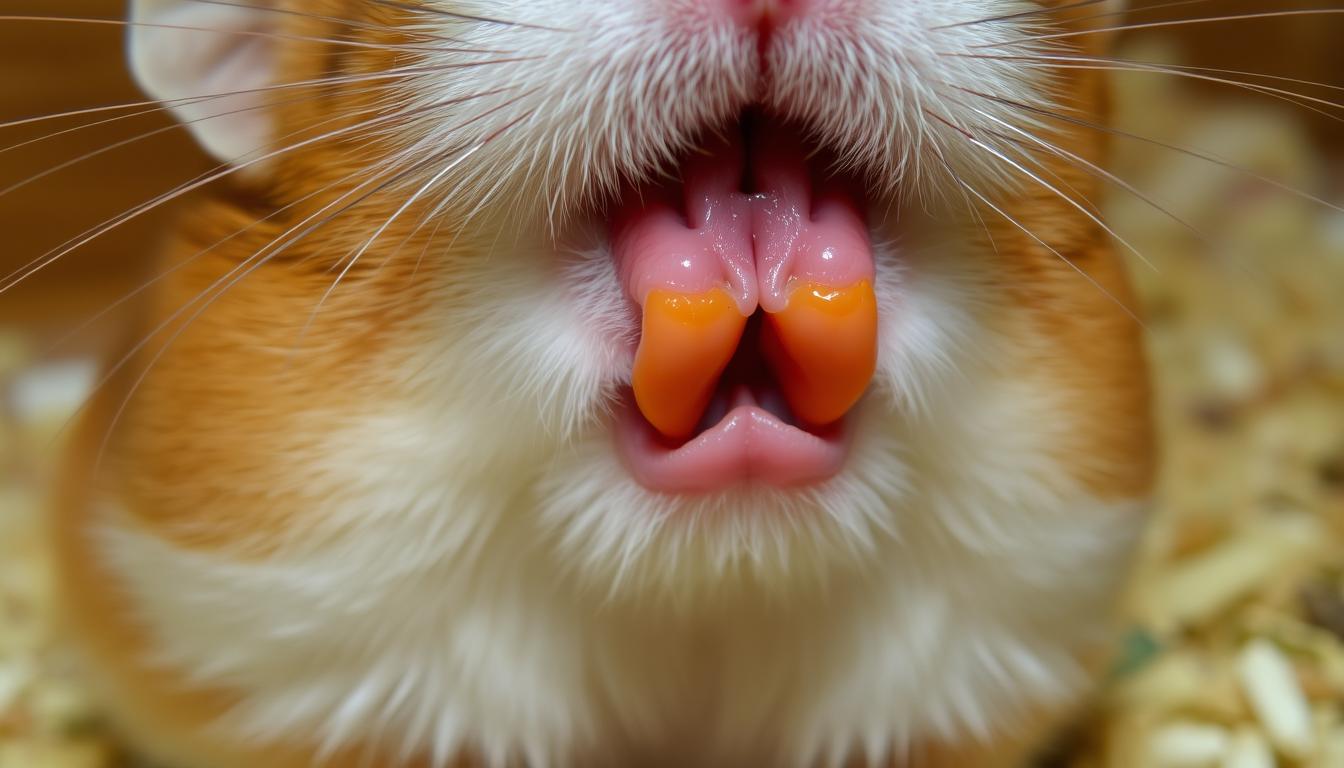Hamsters, those adorable pocket-sized companions, rely heavily on their teeth. They use them for everything from gnawing on food and toys to carrying bedding materials. Because their teeth are so crucial to their well-being, it’s important to understand what healthy hamster teeth should look like. Knowing the characteristics of healthy chompers allows you to spot potential problems early, ensuring your furry friend stays happy and healthy. So, let’s dive into the fascinating world of hamster dentition!
Healthy Hamster Chompers: What Are We Aiming For?
We’re aiming for a set of teeth that are strong, properly aligned, and capable of withstanding the constant gnawing that hamsters are known for. Healthy hamster teeth are a sign of a healthy hamster overall, indicating they’re getting the right nutrients and are free from dental disease. Think of it like this: we want teeth that look ready for action, capable of tackling a sunflower seed with gusto! We’re looking for teeth that allow your hamster to eat comfortably and maintain a healthy weight.
Essentially, we want to see teeth that are appropriately sized for the hamster, not overgrown or excessively worn down. They should be a healthy yellow-orange color, indicating proper mineralization. The teeth should meet correctly, without significant overbite or underbite. And of course, they should be free of any visible signs of damage, like chips, cracks, or unusual growths.
Ultimately, healthy hamster teeth contribute directly to their quality of life. When a hamster’s teeth are in good condition, they can eat properly, groom themselves effectively, and enjoy their daily activities without pain or discomfort. This translates to a happier, more active, and longer-lived hamster.
So, knowing what to look for is the first step in ensuring your hamster’s dental health. Regular observation and a proactive approach to dental care can help prevent problems before they become serious. A healthy set of chompers is a vital component of a happy and healthy hamster life!
It’s not just about the appearance either; functionality is key. A hamster with healthy teeth can properly grind their food, ensuring they receive the necessary nutrients. Poor dental health can lead to malnutrition, weight loss, and a compromised immune system.
Therefore, understanding the characteristics of healthy hamster teeth is an essential part of responsible hamster ownership. It empowers you to provide the best possible care for your furry friend and helps you recognize when veterinary intervention is needed.
Incisors Up Close: Length, Shape, and Ideal Appearance
Hamsters primarily use their incisors, the two prominent teeth in the front of their mouths, for gnawing. These teeth are continuously growing, which is why hamsters need to constantly chew on things to keep them worn down. The ideal length of the incisors is a crucial aspect of their health. If they become too long, they can prevent the hamster from eating properly.
The shape of the incisors is also important. They should be relatively straight, without any significant curvature or twisting. While a slight curve is normal, excessive curvature can indicate a problem with alignment or growth. The incisors should meet evenly, allowing the hamster to effectively grasp and chew food.
Ideally, the incisors should be sharp and well-defined. This allows the hamster to easily break down food and other materials. Blunt or rounded incisors might indicate excessive wear or a lack of proper chewing opportunities. Providing appropriate chewing toys and a balanced diet can help maintain the sharpness of the incisors.
The ideal appearance of the incisors is a smooth, glossy surface. This indicates healthy enamel and proper mineralization. Rough or pitted surfaces can suggest dental problems or nutritional deficiencies. Regular observation of the incisors can help you identify any changes in texture or appearance.
The length of the incisors should be proportionate to the size of the hamster’s head. As a general guideline, they shouldn’t extend excessively beyond the lips when the mouth is closed. Overgrown incisors can be a sign of malocclusion, where the teeth don’t align properly.
Ultimately, healthy incisors are essential for a hamster’s well-being. They allow the hamster to eat properly, maintain a healthy weight, and engage in their natural chewing behaviors. Regular monitoring of the incisors’ length, shape, and appearance is crucial for detecting and addressing any potential dental problems.
Color Me Healthy: Judging Hamster Teeth by Their Hue
The color of a hamster’s teeth is a surprisingly important indicator of their health. Healthy hamster teeth are not pearly white like human teeth. Instead, they should have a distinct yellow or orange hue. This coloration is due to the presence of iron in the enamel, which contributes to the teeth’s strength and durability.
The intensity of the yellow or orange color can vary slightly depending on the hamster’s diet and genetics. However, a consistently pale or white color can indicate a mineral deficiency or other health problem. If you notice a significant change in the color of your hamster’s teeth, it’s best to consult with a veterinarian.
On the other hand, excessively dark or brown teeth can also be a cause for concern. This could be a sign of staining from certain foods or medications, or it could indicate a more serious dental issue like tooth decay. Regular cleaning and a balanced diet can help prevent staining and maintain a healthy tooth color.
The color should be consistent throughout the tooth. Patchy coloration or dark spots can be a sign of enamel damage or infection. These areas may be more susceptible to decay and should be examined by a veterinarian.
It’s important to note that the color of the teeth can also be affected by age. Older hamsters may have slightly darker teeth than younger hamsters. However, any sudden or significant changes in color should be investigated.
In summary, a healthy hamster’s teeth should be a consistent yellow or orange color. Any significant deviations from this color, such as paleness, excessive darkness, or patchy coloration, should be addressed with a veterinarian. Monitoring the color of your hamster’s teeth is a simple yet effective way to assess their overall dental health.
Bite Alignment: How Should a Hamster’s Teeth Meet?
Proper bite alignment, also known as occlusion, is crucial for a hamster’s ability to eat and maintain healthy teeth. Ideally, a hamster’s upper and lower incisors should meet evenly, forming a scissor-like action. This allows them to effectively gnaw on food and other materials.
When the mouth is closed, the upper incisors should slightly overlap the lower incisors. This slight overlap is normal and helps to keep the teeth properly worn down. However, excessive overlap or a significant gap between the teeth can indicate a malocclusion.
Malocclusion, or misaligned teeth, is a common dental problem in hamsters. It can be caused by genetics, injury, or improper diet. When the teeth don’t meet properly, they can become overgrown, leading to difficulty eating and other health problems.
One common type of malocclusion is an overbite, where the upper incisors significantly overlap the lower incisors. Another type is an underbite, where the lower incisors protrude beyond the upper incisors. Both of these conditions can prevent the hamster from properly grinding their food.
In addition to the incisors, the molars (the back teeth) also play a role in bite alignment. The molars should meet evenly, allowing the hamster to effectively chew and grind their food. Problems with the molars can also contribute to malocclusion and difficulty eating.
Regularly checking your hamster’s bite alignment is an important part of their dental care. If you notice any signs of malocclusion, such as overgrown teeth, difficulty eating, or a visible misalignment of the teeth, it’s essential to consult with a veterinarian. Early intervention can help prevent more serious dental problems and ensure your hamster can eat comfortably.
Avoiding the Gaps: Spacing Between Hamster Teeth
While hamsters have incisors that are prominently displayed, it’s important to consider the spacing between them. Ideally, there shouldn’t be significant gaps between the incisors. Gaps can sometimes indicate missing teeth or abnormal tooth growth patterns.
Small spaces might be present naturally, but large gaps are often a sign of a problem. For example, if one incisor is missing due to injury or disease, it will leave a noticeable gap. Similarly, if one incisor is growing at an abnormal angle, it can create a gap between the teeth.
Gaps between the teeth can also lead to food becoming trapped. This trapped food can then decompose, leading to bacterial growth and potentially causing dental infections or gum disease. Regular cleaning and a proper diet can help prevent food from becoming trapped in these spaces.
When examining the spacing between your hamster’s teeth, it’s important to consider the overall alignment. If the teeth are properly aligned and the gaps are minimal, it’s likely not a cause for concern. However, if the teeth are misaligned or the gaps are large, it’s best to consult with a veterinarian.
Furthermore, be mindful of any changes in spacing over time. If the gaps between your hamster’s teeth suddenly increase, it could indicate a developing dental problem. Regular observation can help you detect these changes early.
In conclusion, while some minimal spacing between a hamster’s incisors might be normal, significant gaps should be investigated. These gaps can be a sign of missing teeth, abnormal growth, or other dental problems. Regular monitoring and prompt veterinary care can help maintain your hamster’s dental health.
Smooth Operators: Texture of Healthy Hamster Teeth
The texture of a hamster’s teeth provides valuable clues about their dental health. Healthy hamster teeth should have a smooth, glossy surface. This smoothness indicates healthy enamel, the protective outer layer of the teeth. Smooth enamel helps to resist wear and tear from constant gnawing.
Rough or pitted textures are often a sign of enamel

